The Importance of Specialist Concrete Scanning Solutions
The Importance of Specialist Concrete Scanning Solutions
Blog Article
Unveil the Transformative Power of Concrete Scanning in Maximizing Efficiency and Safety And Security
Concrete scanning has actually emerged as an essential tool in the construction market, providing unequaled benefits in enhancing project efficiency and ensuring safety criteria. By using sophisticated innovation, concrete scanning enables specialists to see past the surface, revealing surprise intricacies that might influence the structural honesty of a building. The transformative power of concrete scanning depends on its capacity to offer detailed understandings and real-time data, changing exactly how projects are prepared and implemented. As we dig right into the details of this ingenious technique, a world of opportunities opens up, showcasing a new age of construction practices that focus on precision and safety and security.
Value of Concrete Scanning
Guaranteeing the structural stability and safety and security of building and construction tasks starts with the critical action of conducting thorough concrete scanning. Concrete scanning is a non-destructive method made use of to discover and map subsurface elements within concrete frameworks.
Furthermore, concrete scanning assists in enhancing job timelines and budget by avoiding unexpected expenses and delays that may develop due to unpredicted obstructions within the concrete. Ultimately, investing in thorough concrete scanning is a positive strategy that improves both performance and safety in construction jobs.
Exactly How Concrete Scanning Functions
Concrete scanning runs as an important device in building projects by utilizing advanced innovations to find and map subsurface elements without triggering architectural damages. Ground Passing Through Radar (GPR) and Electromagnetic Induction (EMI) are two main techniques made use of in concrete scanning. GPR jobs by discharging high-frequency radar pulses into the surface area, which recover when they run into subsurface items or gaps. The moment considered the signal to return indicates the depth and location of the objects. EMI, on the various other hand, makes use of electro-magnetic areas to identify variances in material structures, such as determining rebar or conduits within concrete frameworks.
Throughout the scanning process, the data collected is assessed in real-time, enabling instant identification of prospective risks or barriers below the surface. This info help in decision-making, ensuring that construction activities continue securely and effectively. Additionally, 3D imaging software can be made use of to create comprehensive maps of the subsurface aspects, further boosting job planning and implementation. By employing these sophisticated technologies, concrete scanning dramatically minimizes the risk of costly problems and injuries on building websites.
Advantages of Concrete Scanning
Using innovative scanning modern technologies in building and construction jobs uses a wide range of benefits, enhancing both effectiveness and security on-site. Among the primary advantages of concrete scanning is the ability to spot and situate embedded objects such as rebar, post-tension cords, and channels properly. By determining these aspects before drilling or reducing right into concrete structures, the danger of unintended strikes is significantly decreased, avoiding possible injuries to workers and damages to the framework itself. Concrete scanning aids in preparation and creating a lot more properly, as it gives precise info regarding the area and deepness of structural parts.

Case Studies: Concrete Scanning Success

In an additional case, a building and construction firm utilized 3D visit concrete scanning to examine the problem old concrete frameworks in a historical structure. The thorough scans supplied beneficial understandings into the extent of degeneration and aided prioritize upkeep efforts effectively. By proactively attending to areas of worry recognized through scanning, the business had the ability to expand the lifespan of the framework and make sure resident safety.
These study highlight the transformative power of concrete scanning in boosting performance, precision, and safety in building and construction content jobs.
Applying Concrete Scanning in Projects
Applying innovative scanning modern technologies during building projects has ended up being significantly important for boosting precision and security. By integrating concrete scanning right into job preparation and implementation, construction teams can determine possible dangers, such as rebar or post-tension cable televisions, hidden within concrete structures. This aggressive approach decreases the threat of crashes, delays, and costly rework, ultimately resulting in much more reliable job timelines and budgets.
To implement concrete scanning efficiently, job managers need to team up closely with experienced scanning experts to identify one of the most suitable click here for more info scanning techniques for the certain project needs. Engaging scanning professionals from the very early stages of a task allows the team to create comprehensive scanning strategies that attend to vital areas of worry and ensure detailed information collection.
Additionally, including concrete scanning right into regular task operations can improve decision-making processes, as real-time check data supplies immediate understandings into the condition of concrete frameworks - Concrete Scanning. This data-driven technique facilitates informed problem-solving and enables groups to make changes promptly, cultivating a society of efficiency and safety throughout the project lifecycle

Final Thought
To conclude, concrete scanning plays an essential duty in improving effectiveness and safety and security in building projects. By using advanced technology to map and identify out underlying structures within concrete, this procedure helps to prevent pricey mistakes, ensure structural stability, and minimize dangers on site. With the capacity to uncover surprise aspects and provide accurate data, concrete scanning proves to be an important device for optimizing job outcomes and making best use of total success.
Concrete scanning is a non-destructive technique made use of to detect and map subsurface aspects within concrete structures. In addition, concrete scanning aids in maximizing task timelines and budget by avoiding unforeseen prices and delays that may occur due to unpredicted obstructions within the concrete. One significant situation research involves a large remodelling job where concrete scanning played an important function in ensuring task success.In an additional situation, a construction firm made use of 3D concrete scanning to evaluate the problem of maturing concrete structures in a historic building. By incorporating concrete scanning into project planning and implementation, building teams can identify potential dangers, such as rebar or post-tension cords, concealed within concrete frameworks.
Report this page